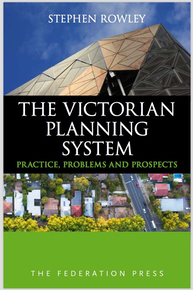Stephen’s second book, The Victorian Planning System: Practice, Problems and Prospects, was released in January 2017. In November 2017 it received a commendation from the Planning Institute of Australia (Victoria) at the annual planning awards, in the Cutting Edge Research and Teaching category. (For his first book, see here).
The book is intended intended as an introduction for new planners and the wider public who need to deal with the planning system (including residents, developers, councilors, and others). For established planners, it considers how our system functions to achieve policy objectives and outlines how it could be improved.
Here’s the publisher’s blurb:
The Victorian Planning System: Practice, Problems and Prospects is a successor to Statutory Planning in Victoria (4th edition) and provides an accessible introduction to the Victorian planning system. Written with both urban planners and users of the system in mind, it seeks to demystify a complex system. The structure and design of planning schemes are explained in simple terms, along with a discussion of how planning decisions are made. Common planning processes – such as planning permit applications, appeals and planning scheme amendments – are covered in detail.
The book is structured around exploration of a variety of urban policy challenges, including housing supply, activity centre planning, heritage and environmental issues. How does planning strategy in these areas translate into action? Too often, the way that the planning system achieves on-the-ground outcomes is glossed over. This book aims to remedy that oversight by exploring the realities of policy implementation through regulatory design. In doing so, it offers a critique of the Victorian system, and suggests ways in which it could more effectively achieve visionary policy goals.
From the foreword by Marcus Spiller:
Dr Stephen Rowley’s book demystifies the planning system in accessible language and with an engaging narrative. Students, practitioners and citizens consulting this volume will be duly empowered to make the most of a system, which, for all its foibles, remains a powerful force shaping our lives.
A key theme of the book is that the common separation between so-called “statutory planning” and “strategic planning” is counterproductive, and that planners need a more integrated approach to regulatory design. The book is therefore structured around a discussion of how the regulatory system responds to various policy dilemmas.
Introduction: Urban Planning and the Regulatory Challenge
The introduction considers the aversion amongst both the general public and urban planners to dealing with the regulatory planning system. It places this in historical context, and considers the way that the link between policy formulation (or strategic planning) and application assessment (statutory planning) can be more constructively conceived.
Chapter 1: Building Blocks of the Victorian Planning System
An overview of the structure of the Victorian system, covering key legislation, the main institutional “players,” and the structure and operation of planning schemes. Written in simple and accessible language, this chapter provides an entry for those unfamiliar with the system.
Chapter 2: Planning Permits and the Application Process
This chapter covers most people’s first interaction with the planning system, the planning permit application process. It steps through the stages in assessment, including discussion of why the process often takes so long. It also describes the structure of a typical planning permit.
Chapter 3: Planning Decisions and System Design
This chapter starts with a detailed discussion of how planning decisions are made, including contentious areas such as the consideration of social and economic effects, the role of policy, the relevance of the number of objections, and the so-called “National Trust principle.” The latter section of the chapter considers how the system is designed to guide these decisions. It defines different types of planning controls and considers the merits of the approach to regulatory design used in Victoria.
Chapter 4: Planning Appeals
This chapter gives a detailed explanation of the process of appealing planning decisions at the Victorian Civil and Administrative Tribunal (VCAT). It runs step-by-step through the appeal process and discusses how hearings are conducted. It also considers the role of the Tribunal, including issues of legalism, cost of access, community perceptions of pro-development bias, and the place of an appeals Tribunal in a democratic system.
Chapter 5: Complications
In order to keep the opening chapters as straightforward as possible, various special cases and detailed issues are considered separately in this chapter. Issues covered included code assessment, VicSmart, applications by government, covenants, amendments to permits (including secondary consent), cancellation of permits, and planning enforcement.
Chapter 6: Planning Scheme Amendments
This chapter considers how the content of planning schemes is formulated and amended. It steps through the planning scheme amendment process and discusses the role of councils, the Department, planning panels, and the Minister. It discusses challenges around the amendment process including timeliness and the adequacy of strategic justification.
Chapter 7: Shops and Houses
Metropolitan strategy is used in this chapter to consider in more detail how the regulatory system is used to achieve policy objectives. In particular, the chapter looks at issues of activity centre policy and efforts to focus and direct residential growth. The implementation of the last two metropolitan plans, Melbourne 2030 and Plan Melbourne, is discussed in detail. The main tool for assessing residential development (ResCode) is examined in depth, along with consideration of controls for higher density development and growth area planning.
Chapter 8: Planning and the Environment
This chapter explores how the planning system manages environmental issues. This includes a discussion of the environmental impact assessment (environment effects statement) regime, and the Environment Protection Act. Planning schemes’ treatment of environmental issues is also discussed using several issue-based case studies: the treatment of sustainable building controls, the management of coastal inundation due to climate change, and bushfire risk).
Chapter 9: Battlefronts
Further issues-based examples of how the system functions are included in this chapter. These include discussion of controls around heritage, various contentious entertainment uses (including brothels, pokies, licensed premises, live music venues, and fast food restaurants) and car parking.
Conclusion: The Way Forward
The conclusion pulls together arguments that are weaved through the remainder of the book, discussing key systemic issues with the planning system and the prospects for change in the future.
Other material
The book includes a glossary, a guide for further reading, index, and copious footnotes to assist the interested reader in seeking further information.
Links


